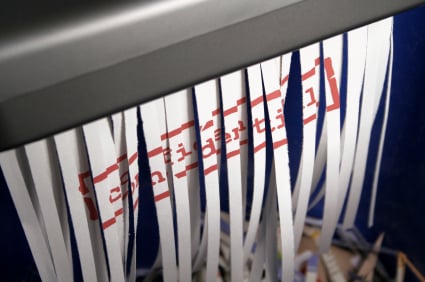
According to financial services consulting firm Javelin Strategies and Research, identity theft affects 11 million people a year, at a cost of $54 billion.
If you don’t want to become a statistic, a good place to start is to get a shredder.
Shredding documents isn’t just for accounting firms and people with something to hide — every day working Americans have houses full of documents containing potentially compromising information, from Social Security numbers to bank account information.
To dispose of them, security experts recommend getting a good cross-cut shredder (which makes your documents into confetti, as opposed to the long strips that a determined thief could reconstruct); one cheap option is this $30 model from Walmart.
OK, got your shredder? Now here’s what to put in it.
Old Tax Returns
As a general rule, you should save your tax returns on the chance you get audited. But after three years, you’re in the clear — that is unless the IRS suspects you are guilty of fraud, in which case the agency can audit you as far back as it likes.
“Keep three to four years of tax returns in a firebox,” says Brent Neiser, senior director of the nonprofit National Endowment for Financial Education. Shred anything older than that.
The biggest concern here is Social Security numbers. Yes, that’s numbers, plural.
“Your dependents’ Social Security numbers are on those, too,” points out Gabby Beltran of the nonprofit Identity Theft Resource Center.
Bank Statements
Anything with bank account numbers should be shredded, and that obviously includes your paper bank statements. That’s especially true for that box of old bank statements you just found in your attic that you don’t know why you kept in the first place.
“There was a time when Social Security numbers were printed on brokerage and bank statements,” says Neiser, who adds that he just went through and shredded all of his old statements.
To avoid having to shred your statements every month, some experts recommend just making the switch to online statements.
“We recommend people turn off bank statements and get as many as you can via email,” says Phil Blank, managing director of security, risk and fraud for Javelin. “The most commonly perpetrated means of defrauding people is to steal things out of their mailbox.”
Credit Card Offers
Unless you’re going to actually take the bank up on its offer and open an account, you should destroy these mailed offers right away.
“A lot if identity theft happens within families, so don’t leave them lying around,” warns Neiser. “Somebody in the house who knows your basic information could fill it out.”
Whether you need to shred or simply rip up the offer is a matter of disagreement among advisers though. The priority is making sure someone doesn’t open a card in your name, but since there shouldn’t be any information like your Social Security number on these offers, you probably don’t need to obliterate them into tiny pieces.
“Offers are good to tear up — I put them in the kitchen trash, around food items,” says Neiser.
Still, tearing it up may not be enough to stop someone from opening up a credit card and shredding your credit rating. A couple years ago, MainStreet reported on someone who tore up a credit card offer, then taped it back together, sent it in and got a credit card from Chase.
Old Photo IDs
Maybe you like to save your old college ID and security badges from previous employers for sentimental reasons; we won’t begrudge you a little scrapbooking.
But if you want to dispose of them, consider using a shredder. While a photo ID alone isn’t enough to steal your identity, keep in mind that the ID — and the information it contains — could be used as part of a larger identity theft scheme to bypass fraud prevention measures.
“A driver’s license has height, weight and date of birth — biometric information they can use to verify an account,” says Beltran.
Pay Stubs
It might not seem like it at first glance, but your pay stub is rife with information that can be used by a skilled identity theft.
“Absolutely shred your pay stubs,” says Blank. “Some [financial] institutions will ask you as validation the amount of your last deposit; if they have that pay stub, they can give the bank that information.”
He adds that the information contained there can also provide a fraudster with other targets.
“They’ll know who your health care provider is, and what bank accounts you have,” he says.
Credit Card Convenience Checks
Credit card companies often send so-called “convenience checks” to cardholders, which are basically checks you can use to borrow against your line of credit for quick cash. Needless to say, you don’t want these to end up in the wrong hands.
“The worst thing people get in the mail are these convenience checks,” says Neiser. “It looks like a credit card bill, but if you open it up, there are checks in there that are live loans ÃÂ that to me is very dangerous.”
If you don’t plan on using these, shred them immediately.
Canceled Checks
Just because you write “void” on it doesn’t mean a canceled check can’t be a ticking time bomb. Remember, your account and routing numbers are listed on the bottom of every check.
“Not only is the bank account number on there, but there’s also your address and possibly your phone number,” says Neiser. “And some people write their full credit card number on the check [to pay their bill].”
As for duplicate checks, those should have the checking account number omitted for your security. But if you have any security concerns, but still want proof of payment, Neiser points out that you can usually request a receipt from the recipient (for your property tax payment, for instance), then shred the duplicate check.
Canceled Credit Cards
Sometimes you need to cancel a debit or credit card — maybe you want to rein in your spending, or you’re leaving your bank, or you suspect the number was stolen. So do you need to shred the old one?
“Theoretically it’s not supposed to be problem, but we recommend that people cut through the magnetic stripe, as there’s encoded information on there,” says Blank. “Also, you don’t want people to know where you bank.”
If your shredder can’t handle plastic, Blank recommends cutting it into four pieces, and then throwing the parts into at least two different trash bags. Hey, you can’t be too careful.
Courtesy: Matt Brownell – Yahoo.com

